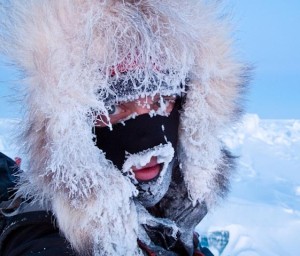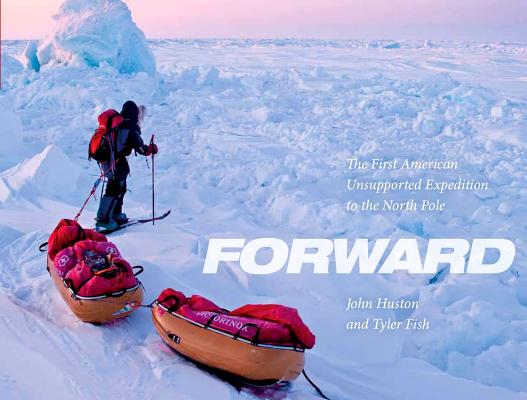
When John Huston was eight years old he wanted to be Indiana Jones, and minus the snakes and booby traps, he’s living that boyhood dream. In 2009 – after years as an Outward Bound wilderness instructor and major expeditions to Greenland and Antarctica – the Evanston adventurer reached the pinnacle of polar exploration with a historic Arctic journey he chronicles in his new book Forward: The First American Unsupported Expedition to the North Pole. Illustrated with breathtaking photos and interwoven with the rich history of polar travel, Forward puts you right alongside Huston and his expedition teammate Tyler Fish as they guide their 300-pound loads over the unforgiving surface of the frozen Arctic ocean on a 55-day adventure that pushed them to the limits of human endurance. On Thursday, May 31st, you can meet Mr. Huston when he visits EPL’s 1st Floor Community Meeting Room at 7 p.m. for a multimedia presentation that includes readings from Forward, a display of expedition gear, and a discussion of the lessons he learned in leadership, teamwork, and perseverance while conquering the North Pole. In anticipation of his visit, we recently spoke with him via email about his love for the wintery North, his 7000 calorie daily diet, the differences between Chicago and Arctic cold, and his upcoming expedition to Ellesmere Island in the Canadian Arctic.
Evanston Public Library: Can you tell us a little about your background as a wilderness guide and polar explorer? What was the Northwestern University program that got you hooked on the outdoors, and how did it inspire you? What is it that draws you to winter and Northern expeditions as opposed to tropical exploration up the Amazon?
John Huston: While I was in school at NU, I co-founded an outdoor orientation program. This program quickly became my huge passion. I just loved teaching and working with people in an outdoor context, the learning setting is unparalleled. After I graduated in 1999, I went to work for Voyageur Outward Bound in Ely, Minnesota, and as soon as I got behind a dogsled I was completely hooked. Winter is so beautiful and clean. The hard work required to work and live in the cold is so satisfying, and it cultivates a special form of camaraderie. Winter is just where I ended up and now I’m wired for it. I’m uncomfortable when the temperature is over 80°F.

EPL: How did you meet your expedition partner Tyler Fish, and how did you decide to tackle the North Pole together? What were the greatest strengths and challenges of your partnership? Do you see much of each other since your return?
JH: Tyler was one of my mentors and co-workers at Outward Bound, and we also raced for the same cross country ski team. The North Pole idea came to me in 2005 while I was on an expedition on Greenland. Partnering with Tyler was a natural fit. We trusted each other and each admired how the other went about things, and we had a shared history at Outward Bound. The pressure of preparation and fundraising really challenged our relationship, but our ability to communicate and be honest with each other forged a stronger partnership in the end. He lives in Ely, MN and I live in Evanston so we only see each other a few times a year, but we talk at least once a week. Writing the book was like doing another expedition together, and it has made us closer than ever. We’re detached from the past and happy with what we accomplished and how we did it.
EPL: Which part of your expedition preparation was the most difficult – physical training, fundraising, or planning and logistics?
JH: Fundraising was most difficult because that is a variable we don’t control and there are a zillion details that go into that side of it. I’ve never been really comfortable with self promotion, but polar expeditions are very expensive. We approached the process with the goal of integrity every step of the way and ended up connecting with some truly wonderful people in industry-leading companies.
EPL: Chicago winters are chilly, but what does Arctic cold feel like? What were the most important steps for taking care of yourself in those extreme conditions?
JH: Chicago is pretty damp in the winter, and these days Chicago winter see-saws over and under 32°F so it’s not really a proper frozen winter. Sometimes this type of freeze-thaw-freeze winter can seem colder because a person’s body doesn’t adapt to the cold and the dampness sharpens the feeling of cold. Arctic cold – for the most part – is dry and slushless, and the snow can be more like fine sand. Arctic cold can really shock the body and mind if you are not ready for it. Your nose hairs freeze when you inhale and you better dress right, eat right, and stay hydrated. Being warm in a northern winter is powerful experience.

EPL: Could you tell us about your daily menu on the expedition and the incredible number of calories you consumed? Was it tough returning to your regular diet after the trip, and have you eaten much pemmican since you got back?
JH: We ate about 6500 to 7000 calories each day. It takes tons of energy to stay warm at -40°F and pull 300-pound loads hour after hour. We ate pemmican stew which is a hearty meat stew laden with a lot of beef fat. We snacked on butter, bacon, fudge bars, and high fat nuts. I haven’t eaten pemmican since, but on the ice we loved every morsel. The only tough part about returning to a regular diet was that our metabolisms slowed down and didn’t allow us to eat as much as we dreamed about while skiing.
EPL: How did your and Tyler’s stated values of optimism, humility, and responsibility help you during your 55-day journey?
JH: Our values bound us together through several rough interpersonal times. They served as guide posts to our decision making and public outreach. If something didn’t align with our values, then we didn’t feel it would be true to us as individuals. Integrity was hugely important to us, and our values kept us grounded in that regard.
EPL: Was it difficult to adjust to life back in Evanston after accomplishing your Arctic mission? Do you ever daydream about fleeing civilization and heading back to the North Pole?
JH: I miss the Arctic and wide open spaces everyday, but when I’m on the ice, I miss aspects of living in a city. Being near Lake Michigan helps. Coming home is always a big adjustment. Of course there are fun on-ice daydreams to realize, but it’s also a challenge to readjust to society. Expeditions are a very focused time, and it can be hard on my family and loved ones. Reintegrating with them takes care and compassion.

EPL: When did the idea of writing a book first arise, and how did it come together after the expedition? What were your biggest challenges?
JH: We always knew we would write a book, but we didn’t start writing until 10 months later. We needed to distance ourselves from the experience. Editing was a huge challenge. It’s a massive puzzle to make the right cuts and highlight the worthy sections. It was a long process, but I loved it.
EPL: What are your future exploration plans and goals? Can you tell us about the expedition you’re planning to Ellesmere Island in the Canadian Arctic?
JH: Ellesmere Island – a gigantic landmass in far northeastern Canada – is one of the most remote and most stunningly beautiful places in the Arctic. I’m headed there next spring, April and May of 2013. The team includes a Norwegian, a Canadian, and a filmmaker from South Africa who lives in Norway. We’ll be skiing and ski-sailing on a few historic expedition routes, and we hope to travel through some areas that have been described as “gloriously unwalked.” One of our goals is to make a documentary film about the region.
Interview by Russell J.
